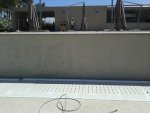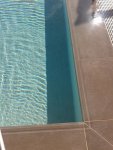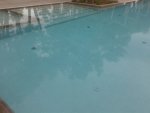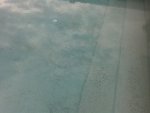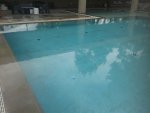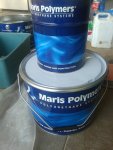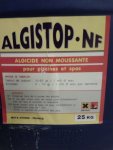Hello everybody,
I am a Mechanical Engineer from Greece and I have a problem which I wanted to share with you, hoping that you would be able to help me.
We constructed a new quartz aggregate swimming pool for a tennis club 5 months ago (25X10m and 1.5m of depth). The color of the quartz used was very similar to that of the sea sand so as to have a color of the water very similar to that of the sea. After 2-3 months of use the pool was in very bad shape. The pool couldn’t be cleaned and after meetings with the constructor of the pool and the constructor of applying the quartz we decided to empty the pool, to clean it with the use of a pressure washer and to apply sealers on top of the quartz surface in order to smoothen the surface and to avoid dirt and algae to remain between the quartz sand. I have uploaded some photos so you can understand how bad the pool had become. Before applying three layers of sealer we applied a layer of Algae stop liquid. I have to admit that the surface of quartz is not totally smooth but still has a rough surface.
After doing all that the pool was in perfect shape. The water was perfect and still is but one month after the filling of water, brown stains have covered the pool surfaced. The stains can be seen more clearly in a cloudy day. I have uploaded some photos and I hope they are clear enough. The water is being monitored all the time and right now it has the following chemical characteristics:
Chlorine: 0.82 mg/l
PH: 7.22
Reedox: 823 mV
Temperature: 25 C
The stains seem to have a slippery surface. The pool has being cleaned every day since the begging but that didn’t seem to help the problem.
I would be really glad if anyone could give me an advice about how to solve the problem.
Thank you for your time.
I am a Mechanical Engineer from Greece and I have a problem which I wanted to share with you, hoping that you would be able to help me.
We constructed a new quartz aggregate swimming pool for a tennis club 5 months ago (25X10m and 1.5m of depth). The color of the quartz used was very similar to that of the sea sand so as to have a color of the water very similar to that of the sea. After 2-3 months of use the pool was in very bad shape. The pool couldn’t be cleaned and after meetings with the constructor of the pool and the constructor of applying the quartz we decided to empty the pool, to clean it with the use of a pressure washer and to apply sealers on top of the quartz surface in order to smoothen the surface and to avoid dirt and algae to remain between the quartz sand. I have uploaded some photos so you can understand how bad the pool had become. Before applying three layers of sealer we applied a layer of Algae stop liquid. I have to admit that the surface of quartz is not totally smooth but still has a rough surface.
After doing all that the pool was in perfect shape. The water was perfect and still is but one month after the filling of water, brown stains have covered the pool surfaced. The stains can be seen more clearly in a cloudy day. I have uploaded some photos and I hope they are clear enough. The water is being monitored all the time and right now it has the following chemical characteristics:
Chlorine: 0.82 mg/l
PH: 7.22
Reedox: 823 mV
Temperature: 25 C
The stains seem to have a slippery surface. The pool has being cleaned every day since the begging but that didn’t seem to help the problem.
I would be really glad if anyone could give me an advice about how to solve the problem.
Thank you for your time.


